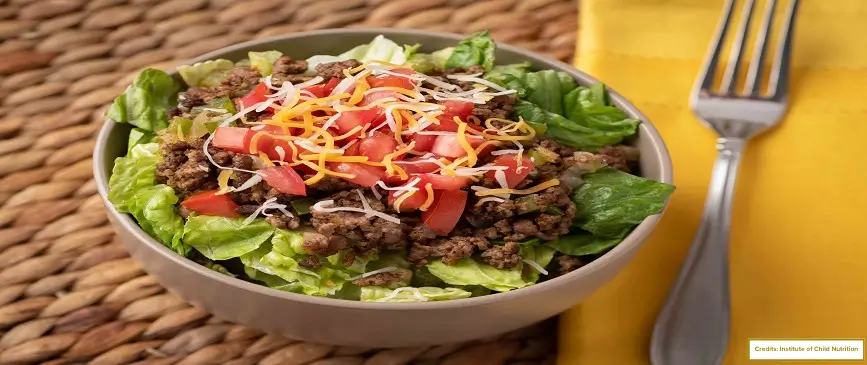Introduction
School cafeteria tables may not be the first thing that comes to mind when designing a school environment, but they play a crucial role in shaping students’ experiences. These tables serve more than just furniture: They encourage social interactions, promote healthy eating habits, enhance student engagement, and contribute to a comfortable dining atmosphere.
Whether designing for an elementary school cafeteria, a private school cafeteria, or high school lunchrooms, selecting the right tables are essential.
In this article, you will explore the multiple factors that need to be considered while choosing the school cafeteria table, the impacts of the right table designs on students, and some of the best types to implement.
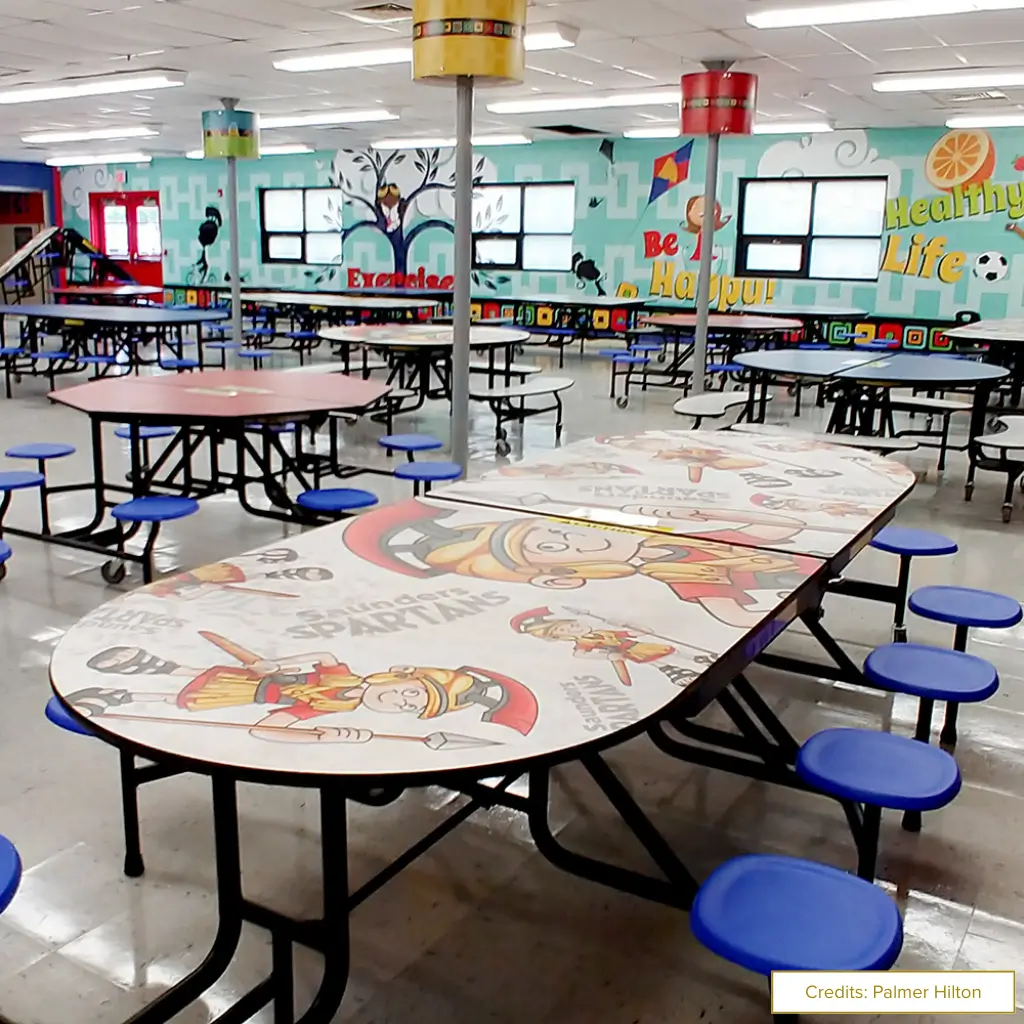
How Table Design Affects Student Experience
Cafeteria tables are more than just eating surfaces; they influence students’ daily lives in multiple ways. Here’s how:
- Psychological Impact: The colors, shapes, and materials used in modern school cafeterias affect learners’ mood, motivation, and even their eating habits. A well-lit, aesthetically pleasing environment encourages kids to make healthier food choices, making lunchtime a more enjoyable and communal experience.
- Encouraging Social Interaction: The arrangement of tables influences how students interact. Shared tables promote inclusivity and teamwork, while U-shaped setups promote interaction and engagement during discussions. Clustered tables support teamwork.
- Improving Behavior & Reducing Noise: Comfortable and organized seating reduces restlessness, distractions, and conflicts, leading to a more positive school culture.
- Healthier Eating Habits: The right cafeteria seating arrangement ensures that students take their time while eating instead of rushing. This helps promote healthy eating by reducing food waste and improving digestion.
- Hygiene and Maintenance: Non-porous materials make cleaning easier and prevent bacteria buildup. Durable, smooth surfaces ensure better hygiene, making it simpler to manage a school cafeteria efficiently.

School Cafeteria Table Design – Factors Checklist
Designing school cafeteria tables requires careful consideration of functionality, safety, ergonomics, aesthetics, hygiene, and inclusivity. Here’s a detailed breakdown of the essential factors to consider:
→ Maximize Space and Flow
Firstly, consider the available space. School cafeterias are busy places, often accommodating hundreds of students at once. Tables need to be proportionate to the space, allowing for easy movement. Keep at least three to four feet of clearance between tables so students and staff can navigate smoothly.
Also, consider the flow of traffic ensuring that lunch lines and food service areas don’t get blocked.
→ Count Shape and Layout
The shape of cafeteria tables matters more than you might think. While unique designs can add to the aesthetics they shouldn’t interfere with cafeteria activities. Choose a shape that complements the space and keeps movement fluid.

→ Opt for Flexibility and Versatility
A great school cafeteria serves multiple purposes. When not in use for lunch, can the space double as a study area, lounge, or meeting spot?
Modular tables with wheels allow for easy rearrangement, and foldable designs make storage a breeze. Consider investing in adjustable-height tables to accommodate various age groups and activities.
→ Variety in Seating Options
One size doesn’t fit all when it comes to cafeteria tables. Offering different seating options makes the space more inviting. Consider large tables for groups of 10 to 12 and smaller tables or booths for more intimate gatherings. Taller bistro tables, counter seating along walls, and even standing-height tables give students a range of comfortable choices.
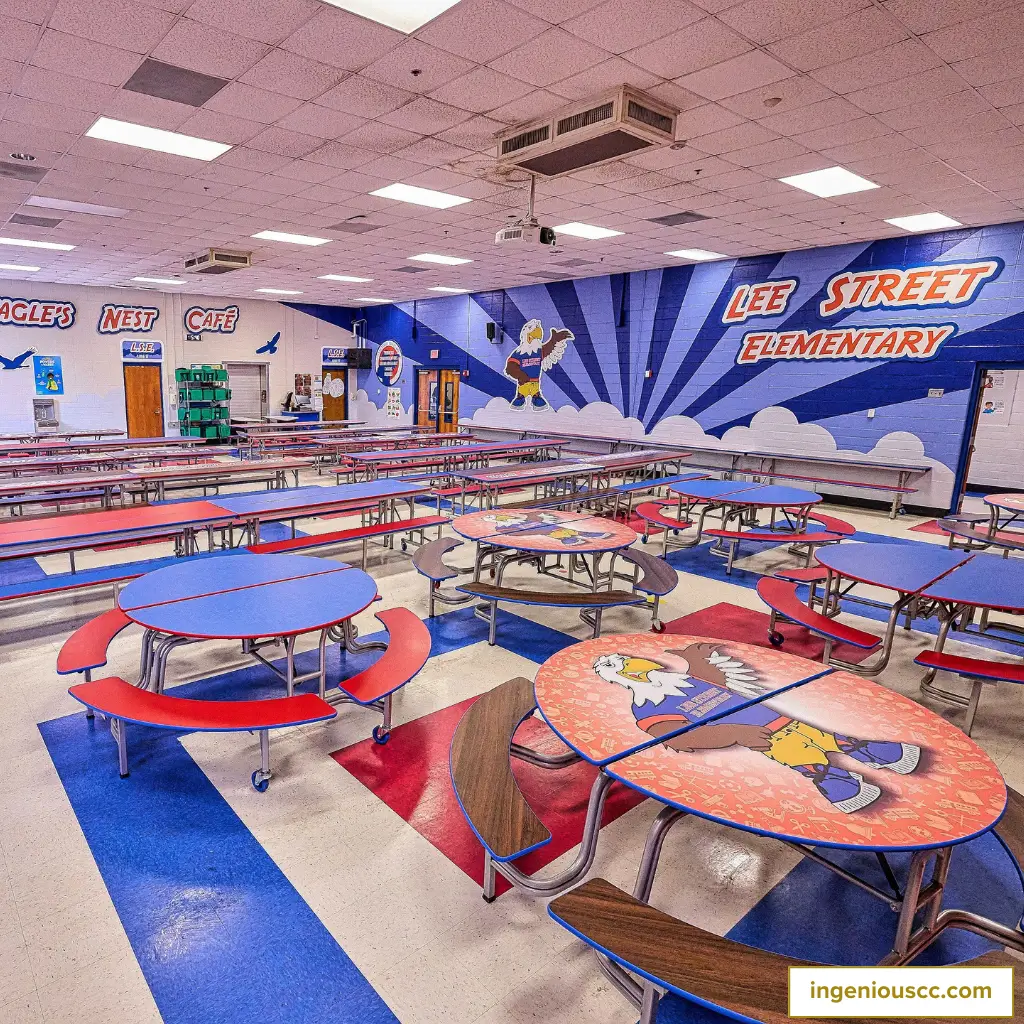
→ Ensure Inclusivity
School cafeterias should be welcoming for all students, including those with disabilities. Universal design principles help ensure that tables are accessible to everyone. Adjustable-height tables, wheelchair-friendly seating, and smooth, easy-to-clean surfaces are all essential. The goal is to provide a plush and dignified dining experience for every student.
→ Prioritize Durability and Safety
School cafeteria tables endure a lot of daily wear and tear, so durability is key. Invest in tables with metal frames and high-pressure laminate tops to hold up well over time. Stainless steel bases are another great option to prevent damage from heavy use. Similarly, scratch-resistant and stain-proof surfaces keep tables looking clean and professional.
→ Focus on Ergonomics
Comfort plays a big role in how students enjoy their lunch breaks. Tables and chairs should promote good posture and provide enough legroom and support for extended use.
Schools can choose between attached seating for a space-saving setup or separate chairs for more flexibility. Adjustable height tables work well for mixed-age groups, ensuring students of all sizes can sit comfortably.
→ Easy Cleaning and Hygiene
Hundreds of students eat in the cafeteria daily making hygiene a top priority. Tables should be lightweight yet sturdy enough to move for cleaning. Avoid designs with unnecessary crevices where food can accumulate.
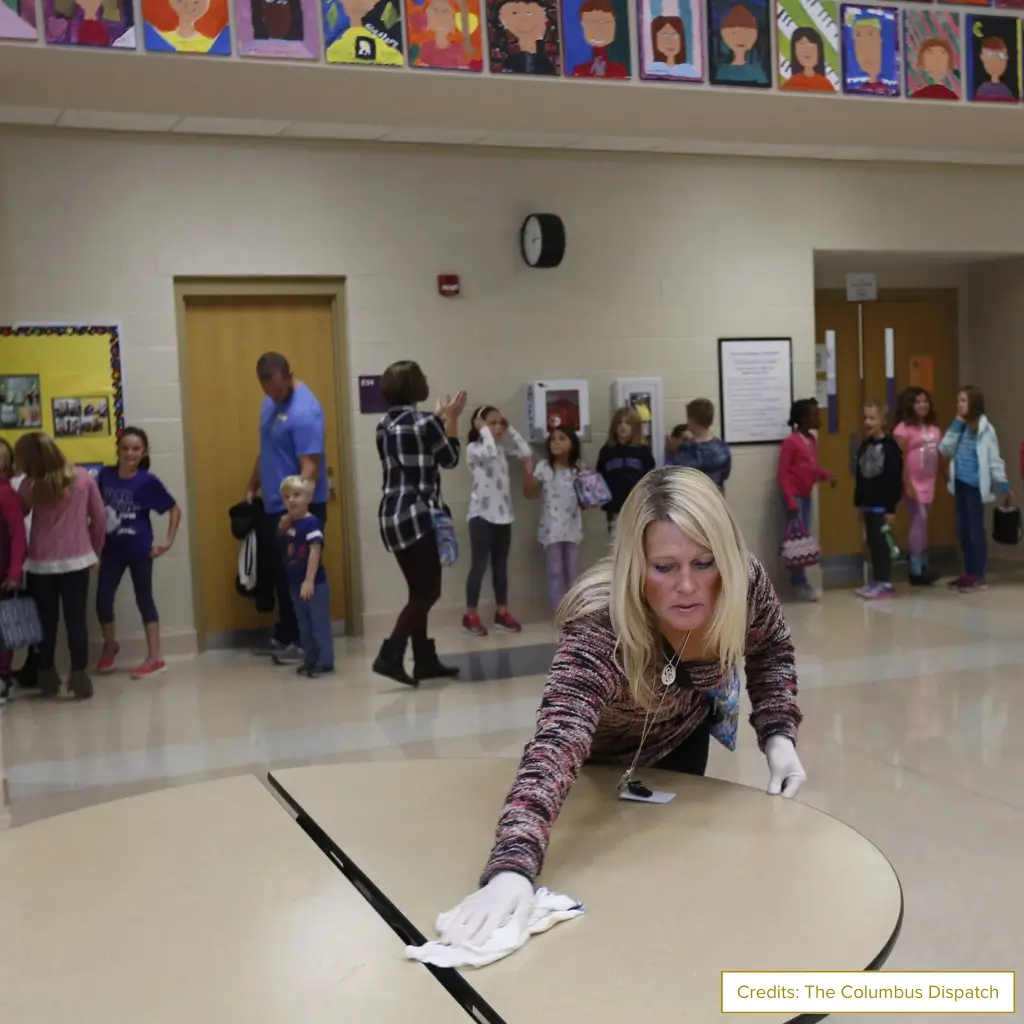
→ Noise Reduction
Cafeterias can get loud, making it difficult for students to enjoy their meals. To reduce noise in the cafeteria opt for tables with noise dampening materials. Adding rubber padding to the bottom of tables and chairs can minimize clatter.
Soft, cushioned seats or sound-absorbing wall panels can also help keep noise levels manageable.
→ Incorporate Aesthetic Elements
The cafeteria design should reflect the school’s identity and the students’ needs. For instance, when designing middle school cafeteria tables, feature school colors or sports team logos. For high school, incorporate school branding, motivational quotes, and college-inspired themes. For elementary, fun shapes like circles, hexagons, or kidney-shaped tables can encourage playfulness and social interaction.
→ Emphasize Sustainability and Technology
Looking ahead, future school cafeterias will likely focus on even more flexibility, sustainability, and technology integration. Schools might incorporate smart furniture, eco-friendly materials, or multi-purpose layouts that support various student activities beyond just meals.
Different Types of Cafeteria Tables
There are several styles of cafeteria tables, each catering to different needs and settings.
→ Folding Tables
These are ideal for schools that use the cafeteria for multiple purposes. They are easy to store and move around, making them highly versatile.
→ Traditional Rectangular Tables
These tables offer maximum seating capacity and are a popular option for all grade levels. However, they can sometimes feel crowded, making them less ideal for promoting personal space and relaxation.
→ Mobile Folding Tables
Equipped with wheels, these tables can be easily moved and stored. They are perfect for schools with flexible cafeteria layouts but require durable construction to withstand frequent movement.
→ High-top or Bar-Height Tables
These tables provide a contemporary setting and encourage casual interactions. However, they may not be suitable for younger students.
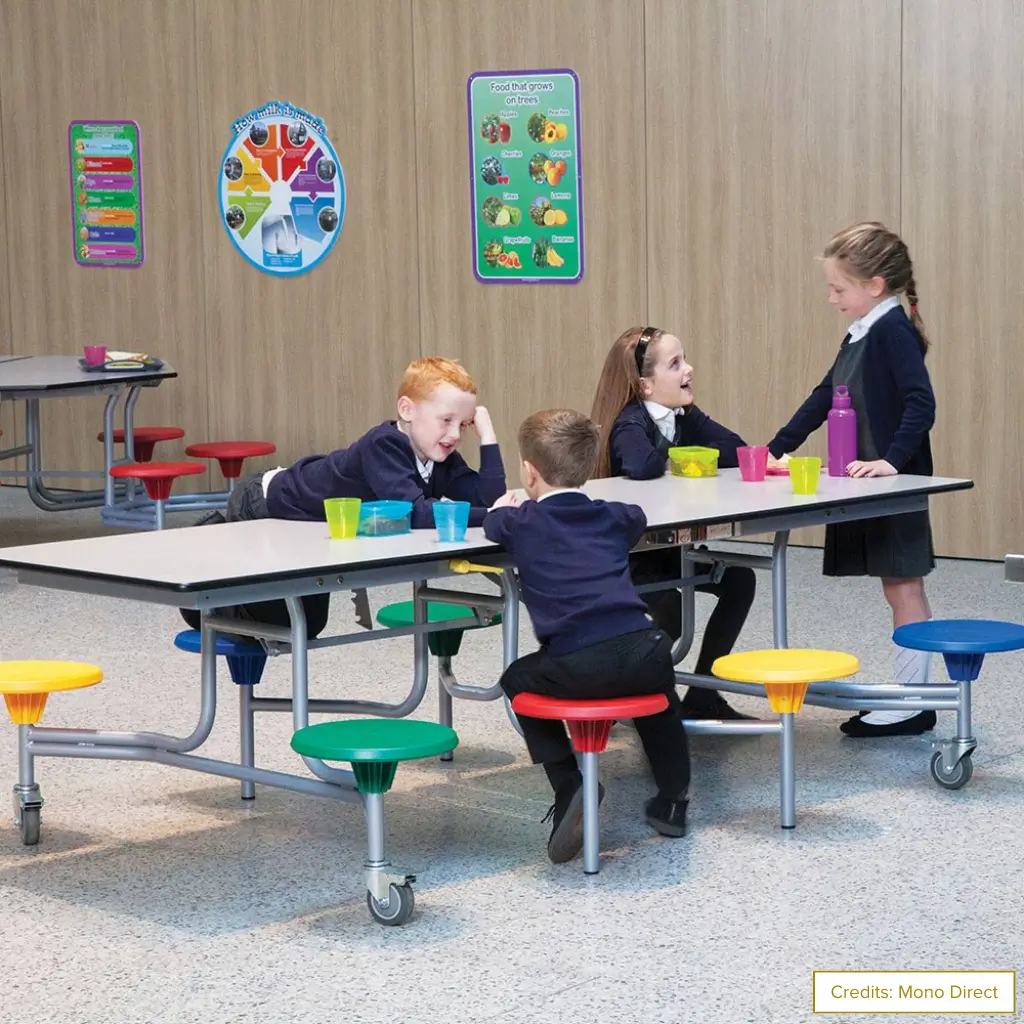
Conclusion
In summary, choosing the right cafeteria tables directly impacts student comfort, well-being, concentration, and behavior. By focusing on durability, flexibility, and inclusivity, schools can create inviting cafeterias that effectively serve students’ needs. Whether indoors or in an outdoor school cafeteria, a well-planned dining area fosters a sense of community while ensuring practical functionality.
FAQs
How do I choose the right table size for my school cafeteria?
Consider the number of students, available space, and seating arrangement preferences. A mix of table types can help optimize seating capacity while allowing flexibility.
Should cafeteria tables have attached seats or separate chairs?
Attached seats prevent chairs from being moved around and save space, while separate chairs offer more flexibility in seating arrangements.
What is the best way to maintain school cafeteria tables?
Regular cleaning with non-abrasive cleaners, checking for loose parts, and using protective coatings can help maintain cafeteria tables for long-term use.

